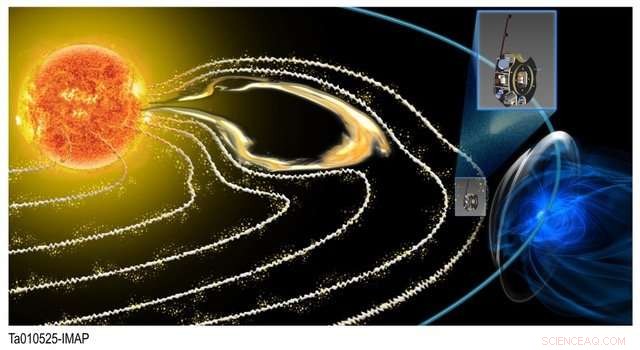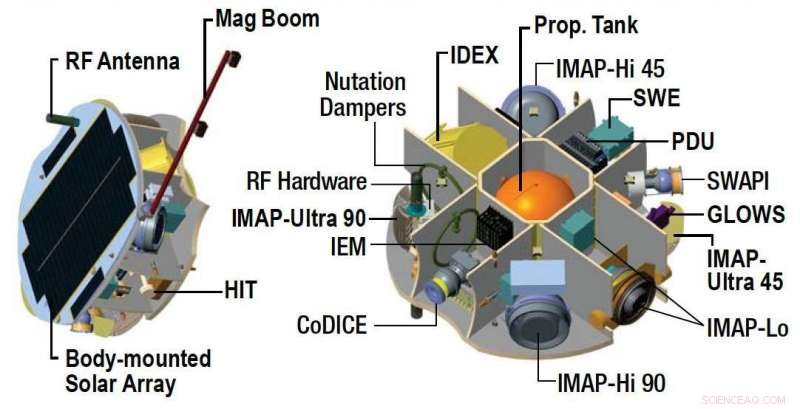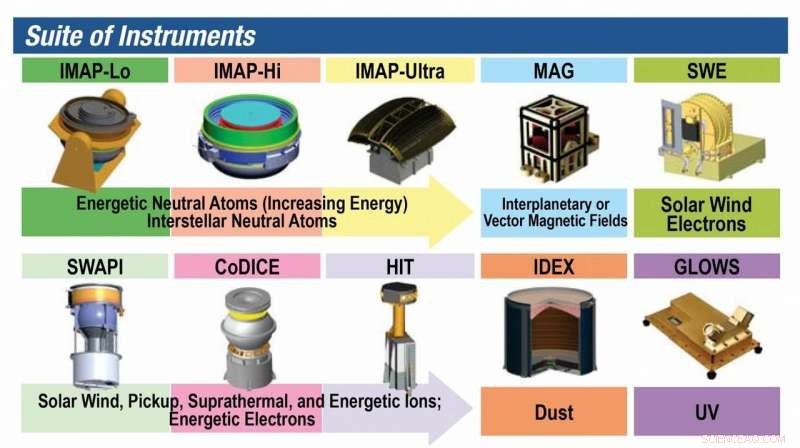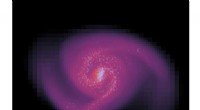
Wetenschap
Princetons McComas zal IMAP leiden, een NASA-missie om de heliosfeer te bestuderen

Princeton-astrofysicus David McComas wordt de hoofdonderzoeker voor de Interstellar Mapping and Acceleration Probe (IMAP), een missie die in 2024 wordt gelanceerd om de heliosfeer te onderzoeken, het gebied waar deeltjes die uit de zon stromen een bel uitkerven in het interstellaire medium. IMAP zal om de zon draaien op L1, een miljoen mijl zonwaarts van de aarde, waar het zich buiten de beschermende omhulling van het aardmagnetisch veld zal bevinden (hier in blauw weergegeven). Tegoed:IMAP-team
Princeton-astrofysicus David McComas zal de hoofdonderzoeker zijn voor een wetenschappelijke missie om monsters te nemen, analyseren en in kaart brengen van deeltjes die van de zon en van de randen van de interstellaire ruimte naar de aarde stromen. Hij presenteert de doelen en status van de missie op de internationale commissie voor ruimteonderzoek (COSPAR) die vandaag in Pasadena bijeenkomt, Californië.
Gepland om in 2024 te lanceren, de Interstellar Mapping and Acceleration Probe (IMAP) missie zal de heliosfeer onderzoeken, die ons zonnestelsel omringt en beschermt, NASA-functionarissen hebben 1 juni aangekondigd.
In het grensgebied van de belvormige heliosfeer, de zonnewind - de gestage stroom van deeltjes die vanuit onze zon in alle richtingen uitstoten - botst met deeltjes uit het interstellaire medium, de niet-helemaal lege ruimte tussen de sterren. De meeste schadelijke kosmische straling wordt in deze grens afgeschermd; IMAP verzamelt en analyseert de deeltjes die er doorheen komen, evenals anderen die in deze kritieke regio worden gegenereerd.
"IMAP onderzoekt tegelijkertijd twee van de belangrijkste problemen in de heliofysica van vandaag - de versnelling van energetische deeltjes en de interactie van de zonnewind met het interstellaire medium, " zei McComas, een professor in astrofysische wetenschappen en vice-president van het Princeton Plasma Physics Labratory.
De missie van $ 492 miljoen omvat een reeks van 10 instrumenten die zullen samenwerken om wetenschappelijke vragen over de zonnewind en het interstellaire medium op te lossen, van eenvoudig - wat is daar precies? - tot complex:hoe werken zonnedeeltjes samen met interstellaire deeltjes, en hoe evolueert die interactie in tijd en ruimte?
IMAP zal ook gegevens verzamelen over hoe kosmische straling door de heliosfeer wordt gefilterd. Deze deeltjes vormen risico's voor astronauten en technologische systemen, en kan een rol spelen in de aanwezigheid van het leven zelf in het universum.
Een groot deel van de bescherming van de aarde tegen kosmische straling vindt plaats vanwege de heliosfeer, zei Dennis Andrucyk, plaatsvervangend associate administrator voor NASA's Science Mission Directorate in Washington, D.C. "IMAP is van cruciaal belang voor het verbreden van ons begrip van hoe dit 'kosmische filter' werkt. De implicaties van dit onderzoek kunnen veel verder reiken dan de overweging van aardse effecten als we ernaar streven mensen de verre ruimte in te sturen."
IMAP zal in een baan rond een punt ongeveer een miljoen mijl zonwaarts van de aarde draaien bij het eerste LaGrange-punt (L1), een astronomische locatie waar de aantrekkingskracht van de zon in evenwicht is met die van de aarde. IMAP blijft tussen de zon en de aarde, waardoor sommige instrumenten in-situ zonnewinddeeltjes kunnen onderzoeken, terwijl andere de verste uithoeken van het zonnestelsel in kaart brengen.
De missie is ontworpen om haar basisdoelen binnen de eerste twee jaar te bereiken, maar het heeft genoeg energie en verbruiksartikelen om minstens vijf jaar bij L1 te overleven. om een nog groter wetenschappelijk rendement mogelijk te maken.

Princeton-astrofysicus David McComas wordt de hoofdonderzoeker voor IMAP, een wetenschappelijke missie van $ 492 miljoen om te proeven, deeltjes van de zon en van de randen van de interstellaire ruimte analyseren en in kaart brengen. Gepland om in 2024 te lanceren, de Interstellar Mapping and Acceleration Probe-missie zal de heliosfeer onderzoeken, die ons zonnestelsel omringt en beschermt. IMAP is een roterende satelliet ter grootte en vorm van een peuterdraaimolen, 6,5 voet in diameter en 2 voet lang (ongeveer 200 cm x 70 cm). Alle wetenschappelijke instrumenten zullen continu draaien terwijl het vier keer per minuut in de ruimte draait. De 10 instrumenten op IMAP zijn "high-erfgoed, vlucht-bewezen" tools, wat betekent dat ze erg lijken op instrumenten die met succes zijn gebruikt tijdens een of meer eerdere missies. Drie van de instrumenten - IMAP-Lo, IMAP-Hi en IMAP-Ultra -- zullen energetische neutrale atomen gebruiken om deeltjes uit de onzichtbare heliosfeer en daarbuiten te "zien". De sensoren worden gekalibreerd in dezelfde faciliteiten als vergelijkbare instrumenten van eerdere missies, waardoor IMAP kan bouwen op basis van de dataset die zich sinds 2008 heeft verzameld. De drie IMAP-instrumenten hebben een hogere resolutie en vele malen de verzamelkracht van de vorige missies (gemiddeld 15 keer, 25 keer en 35 keer, respectievelijk, voor de drie instrumenten). Vijf instrumenten -- CoDICE, RAKEN, MAG, SWAPI en SWE -- zullen verschillende componenten van de zonnewind en energetische deeltjes meten die een gedetailleerd begrip van deeltjesversnelling mogelijk maken, evenals het verstrekken van real-time gegevens over het ruimteweer op weg naar de aarde. De andere twee instrumenten, IDEX en GLOWS, zal kijken naar interstellair stof en ultraviolette straling. Krediet:IMAP-team
Maak kennis met IMAP
IMAP is een roterende satelliet ter grootte en vorm van een peuterdraaimolen, 6,5 voet in diameter en 2 voet lang (ongeveer 200 cm x 70 cm). Alle wetenschappelijke instrumenten zullen continu draaien terwijl het vier keer per minuut in de ruimte draait. De 10 instrumenten op IMAP zijn "high-erfgoed, vlucht-bewezen" tools, wat betekent dat ze erg lijken op instrumenten die met succes zijn gebruikt bij een of meer eerdere missies.
Drie van de instrumenten:IMAP-Lo, IMAP-Hi en IMAP-Ultra - zullen energetische neutrale atomen gebruiken om deeltjes uit de onzichtbare heliosfeer en daarbuiten te "zien". De sensoren worden gekalibreerd in dezelfde faciliteiten als vergelijkbare instrumenten van eerdere missies, waardoor IMAP kan bouwen op basis van de dataset die zich sinds 2008 heeft verzameld. De drie IMAP-instrumenten hebben een hogere resolutie en vele malen de verzamelkracht van de vorige missies (gemiddeld 15 keer, 25 keer en 35 keer, respectievelijk, voor de drie instrumenten).
Vijf instrumenten:CoDICE, RAKEN, MAG, SWAPI and SWE—will measure different components of the solar wind and energetic particles that will allow the detailed understanding of particle acceleration, as well as providing real-time data about the space weather heading toward Earth.
The other two instruments, IDEX and GLOWS, will look at interstellar dust and ultraviolet radiation.
As the principal investigator for the entire IMAP mission, McComas is leading the team that includes scientists from 24 institutions in the United States, Duitsland, Polen, Switzerland and Japan. He is also the lead investigator for the SWAPI instrument.
"The IMAP science team consists of many of the world's leaders in instrumentation, data analysis, theory and modeling, and understanding of the global heliosphere, " McComas said. Together, IMAP's 10 instruments will provide "the first comprehensive in-situ and remote global observations to discover the fundamental physical processes that control our solar system's evolving space environment."
Focus on the IMAP instruments
IMAP-Lo, a single-pixel neutral atom imager mounted on a pivot platform, will measure low-energy (5-1000 eV) interstellar neutral atoms of hydrogen, helium, oxygen, neon and deuterium.

The 10 instruments aboard the Interstellar Mapping and Acceleration Probe will investigate the heliosphere under the leadership of Princeton astrophysicist David McComas:IMAP-Lo, a single-pixel neutral atom imager mounted on a pivot platform, will measure low-energy (5-1000 eV) interstellar neutral atoms of hydrogen, helium, oxygen, neon and deuterium.IMAP-Hi has two single-pixel imagers that will measure mid-energy neutral atoms (0.4-15.6 keV) at 4° angular resolution.IMAP-Ultra's two identical imagers will use slit optics to cover three-quarters of the full celestial sphere with each spin. It will measure high-energy (3-300 keV) neutral atoms with 2° resolution.The Compact Dual Ion Composition Experiment (CoDICE) will measure the composition and movement of two broad energy ranges of ions simultaneously, to advance our understanding of particle acceleration in the heliosphere.The High-energy Ion Telescope (HIT) is a spectrometer that will inventory the charge, energie, orientation and mass of ions from hydrogen to nickel, to determine whether they originate in the solar wind or the interstellar medium.MAG, a pair of identical magnetometers, will measure the local interplanetary magnetic field and provide new insights into the waves and turbulence of the solar wind's plasma.The Solar Wind Electron (SWE) instrument will measure the 3-dimensional distribution of thermal and suprathermal electrons (1 eV-5 keV). SWE is optimized to detect in-situ solar wind electrons at L1 to understand the solar wind structures and provide context for the energetic neutral atom measurements.The Solar Wind and Pickup Ion (SWAPI) instrument, which Princeton's David McComas is the lead investigator for, will measure the solar wind ions as well as hydrogen and helium "pickup ions" from the interstellar medium.The Interstellar Dust Experiment (IDEX) will provide the first accurate in-situ measurements of the flux, size distribution and chemical composition of interstellar dust particles flowing through our solar system.The Global Solar Wind Structure (GLOWS) instrument will measure the ultraviolet glow from interstellar hydrogen and helium, providing ionization, radiation pressure and solar wind measurements and allowing scientists to map out the structure of the solar wind. Credit:IMAP team
IMAP-Hi has two single-pixel imagers that will sweep a circle in the sky with every spin of the rotating satellite. They will measure mid-energy neutral atoms (0.4-15.6 keV) at 4° angular resolution.
IMAP-Ultra consists of two identical imagers using slit optics to cover three-quarters of the full celestial sphere with each spin. It will measure high-energy (3-300 keV) neutral atoms with 2° resolution.
The Compact Dual Ion Composition Experiment (CoDICE) will measure the composition and movement of two broad energy ranges of ions simultaneously, in order to advance our understanding of particle acceleration in the heliosphere.
The High-energy Ion Telescope (HIT) is a spectrometer that will inventory the charge, energie, orientation and mass of ions from hydrogen to nickel, to determine whether they originate in the solar wind or the interstellar medium.
MAG, a pair of identical magnetometers, will measure the local interplanetary magnetic field and provide new insights into the waves and turbulence of the solar wind's plasma.
The Solar Wind Electron (SWE) instrument will measure the 3-dimensional distribution of thermal and suprathermal electrons from 1 eV to 5 keV. SWE is optimized to detect in-situ solar wind electrons at L1 in order to understand the solar wind structures and provide context for the energetic neutral atom measurements.
The Solar Wind and Pickup Ion (SWAPI) instrument, which Princeton's David McComas is the lead investigator for, will measure the solar wind ions as well as hydrogen and helium "pickup ions" from the interstellar medium.
The Interstellar Dust Experiment (IDEX) will provide the first accurate in-situ measurements of the flux, size distribution and chemical composition of interstellar dust particles flowing through our solar system.
The Global Solar Wind Structure (GLOWS) instrument will measure the ultraviolet glow from interstellar hydrogen and helium, providing ionization, radiation pressure and solar wind measurements and allowing scientists to map out the structure of the solar wind.
 Afbeelding:Nederland vanuit een baan om de aarde
Afbeelding:Nederland vanuit een baan om de aarde Voorbeelden van Biogeographical Proof for Evolution
Voorbeelden van Biogeographical Proof for Evolution Planners weten bedroevend weinig over de gevolgen van een stad voor onze geestelijke gezondheid
Planners weten bedroevend weinig over de gevolgen van een stad voor onze geestelijke gezondheid China wordt geconfronteerd met aanzienlijk warmere zomers en winters in 2050
China wordt geconfronteerd met aanzienlijk warmere zomers en winters in 2050 Onderscheidende MJO-activiteit tijdens 2015/2016 super El Nino
Onderscheidende MJO-activiteit tijdens 2015/2016 super El Nino
Hoofdlijnen
- Welke voordelen bieden celwanden plantencellen die contact maken met zoet water?
- Hoge nachttemperaturen hebben een negatieve invloed op de productie van koolzaadplanten
- Wetenschappers vinden potentiële wapens voor de strijd tegen antibioticaresistentie
- Canadese kariboes, habitat blijft afnemen:rapport
- De functie van macromoleculen
- Wat zijn de belangrijkste functies van Cilia & Flagella?
- Onderwaterkwekerijen helpen de mediterrane visbestanden nieuw leven in te blazen
- Bloem of vlees? Genetica verklaart de voorkeur van muggen
- Studie onthult onderliggende genetische basis voor communicatie en sociaal gedrag van halictidebijen
 Kinderen leren hoe ze nummers moeten schrijven
Kinderen leren hoe ze nummers moeten schrijven Gestrand zonder doorvoer? Onderzoekers zeggen dat 1 miljoen Canadezen lijden aan transportarmoede
Gestrand zonder doorvoer? Onderzoekers zeggen dat 1 miljoen Canadezen lijden aan transportarmoede Bestaat donkere materie uit axionen? Zwarte gaten kunnen het antwoord onthullen
Bestaat donkere materie uit axionen? Zwarte gaten kunnen het antwoord onthullen De toekomst van elektronica is licht
De toekomst van elektronica is licht Hoe intelligente werkstations AI zullen gebruiken om gezondheid en geluk te verbeteren
Hoe intelligente werkstations AI zullen gebruiken om gezondheid en geluk te verbeteren Nieuw onderzoek onthult hoe water in de diepe aarde aardbevingen en tsunami's veroorzaakt
Nieuw onderzoek onthult hoe water in de diepe aarde aardbevingen en tsunami's veroorzaakt Wat zijn biologische buffers?
Wat zijn biologische buffers?  Studie van de levensduur van sterrenvlekken op basis van lichtcurveamplitude en spectraaltype
Studie van de levensduur van sterrenvlekken op basis van lichtcurveamplitude en spectraaltype
- Elektronica
- Biologie
- Zonsverduistering
- Wiskunde
- French | Italian | Spanish | Portuguese | German | Dutch | Danish | Norway | Swedish |

-
Wetenschap © https://nl.scienceaq.com






